
© Railway Wonders of the World 2012-


“Super Flyers” of America
The Fastest and Most Luxurious Trains in the World
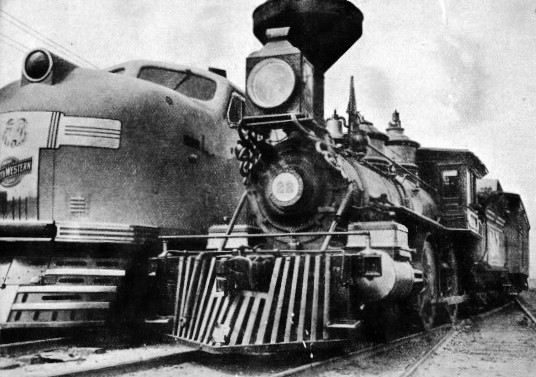
THE NEW AND THE OLD, a striking comparison. On the left is a streamlined Diesel-
THE fastest and most luxurious trains in the world are found in the United States of America, where the railroad received its most enthusiastic welcome. In America, the railway-
As a result, it is venerated as one of the sturdiest of pioneers, and there is a genuine deference in the genera! attitude towards it. It can never be regarded as a child that grew slowly to manhood, altering the general scheme of existence as the years went by, for it arrived as a healthy youngster nursed to comparative maturity in Great Britain, and more than capable of doing a man-
Before it came, the only land link for people between New York and San Francisco was the covered wagon, with its trail of hardship and danger, and even death. Then the railroad arrived and unfolded itself with surprising speed across the prairies of the far west, and the blood and smoke that heralded its approach are mainly responsible for the romance and drama that have grown up around it.
Even today, romance can be seen in the names given to some of the most modern Diesel-
It is not surprising, therefore, that a country which admittedly owes so much to the railroad should have built within its borders nearly a third of all the railways in the world. If all the running lines, branch lines and sidings were laid end to end, it would take a train travelling at a mile a minute roughly nine months to complete the journey, or conversely, there would be sufficient track to make a hundred and twenty-
Many hundreds of independent railways make up the American network. There is a tendency, however, for some of the larger and more famous systems to group other connecting lines under their control as subsidiaries. The New York Central System affords a good example, combining no fewer than six different railways, with altogether more than eleven thousand miles of line.
Grand Central Terminal
Its hub is the Grand Central Terminal in New York, one of the most palatial railway stations ever built, with more than fifty million people passing through it every year. Its entrance hall (or main-
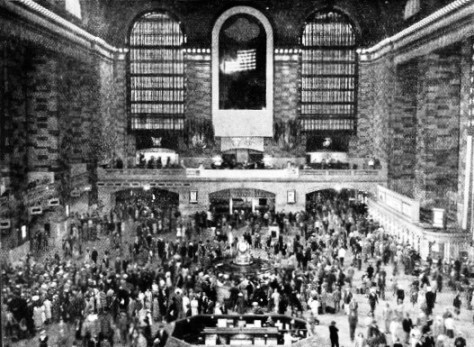
PALATIAL RAILWAY STATION: Grand Central Terminal in New York. More than fifty million people pass through it every year. The main concourse, shown here, is over a hundred and twenty feet in height and width, and more than twice this in length.
Sunlight streams through three immense south windows during the day; concealed fluorescent lighting makes day out of night. Shops are grouped round the hall, and a cinema, an art gallery and a restaurant open off it. Altogether, that part of the station structure seen above ground is over seven hundred feet long and nearly four hundred feet wide, yet this is only a small fraction of the whole, for the greater part is underground.
Here there is an enormous cavern blasted out of solid rock and roofed in with, concrete and steel. This is the part in which the tracks are laid and in which the trains are constantly moving. At twenty feet below the surface there are forty-
Trains enter the Grand Central Terminal by way of a long four-
Three boxes, with modern electric signalling, control the movement of trains. Tower A, in which there are always five signalmen at work, controls all train movements into and out of the forty-
The electric signalling of the four tracks through the entrance tunnel is reversible, and enables traffic to be regulated ingeniously during the rush hours. In the morning, only one of these tracks is kept for outgoing trains and the other three are used for trains coming in, whereas in the evening, roughly between five and six o’clock, the process is reversed. Then three tracks are used for outgoing trains and only one is reserved for trains arriving.
Beyond the end of the tunnel, there are acres and acres of carriage sidings at Mott Haven, and one-
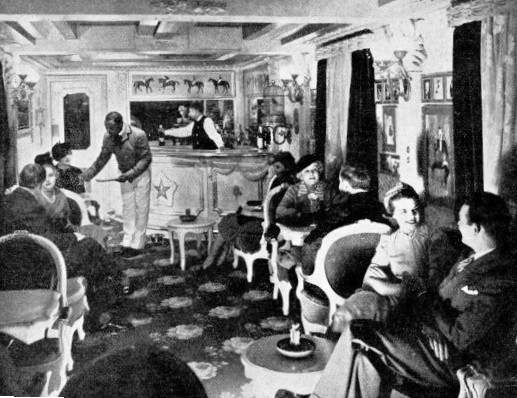
INTERIOR OF CLUB CAR on the “City of Los Angeles”, popular streamliner running between Chicago and Los Angeles. The passenger has a sense of luxury and comfort here equivalent to that to be found in any first-
Another giant station in New York is the Pennsylvania Terminal, similarly below ground level, though in this case it was necessary to tunnel under the broad Hudson River to bring the trains into the city from the New Jersey side of the water. Pennsylvania Terminal, however, is not really a terminus, as the lines continue on to Sunnyside, a suburb of Brooklyn on Long Island, and are used by the Long Island suburban trains. The Pennsylvania Terminal is also used by long-
These great stations in New York are typical of main-
American stations rarely provide any comfort on the actual platforms, which are often no more than covered footways at ground level alongside the track. All the comfort is provided in the palatial station buildings, and passengers generally remain in the building until the time comes to join the train. This is a practice that has grown out of climatic conditions, for in a North American winter it would often be far too cold to wait on any exposed platform, no matter what precautions were taken.
It is not stations alone, however, that have grown in America to a size and magnificence far outstripping anything on European railway systems. The locomotives have developed far beyond European standards, and have changed almost out of recognition from the chugging old-
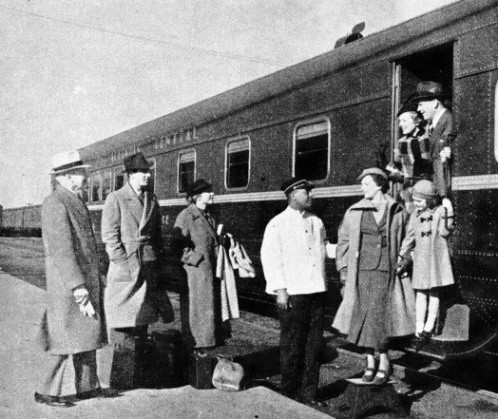
TYPICAL AMERICAN STATION. Most American stations have low-
The fact that they left more room round their tracks in the beginning has made it possible for the Americans to develop the size of their locomotives. The rail gauge is the same as over most of Europe, namely the standard of 4 ft 8½ inches, but they can build as high as sixteen feet above rail level and to a width of ten feet without fouling bridges or lineside structures.
This makes a surprising difference. As an example, the big streamlined Hudson steam locomotives that work the famous “Twentieth Century Limited” from New York to Chicago weigh as much as a hundred and sixty-
This is fully loaded, with the tender carrying twenty-
For over a hundred miles of the journey, from Elkhart to Toledo, they average as much as seventy-
On many of the main lines with heavy grades, the favourite wheel arrangement for fast passenger and freight work is 4-
Needless to say, manual firing of such engines would be completely beyond the power of any human fireman. On most of these larger types, therefore, automatic firing is installed, and this, by means of a worm-
The consumption of fuel by such giants is so heavy that on many main lines there are coal stages for the replenishment of tenders. These are erected across the main track, and under these the locomotive stops in the course of its run to fill up.
Water, as usual, is a simpler proposition, being scooped up at speed from troughs, or “track-
It has been made possible simply by redesigning the scoops so that they reach their maximum efficiency at the higher speed. At this speed, it has been found possible to take in as much as seven thousand gallons at a single gulp, from a track-
The absolute maximum in size for a locomotive is reached in the so-
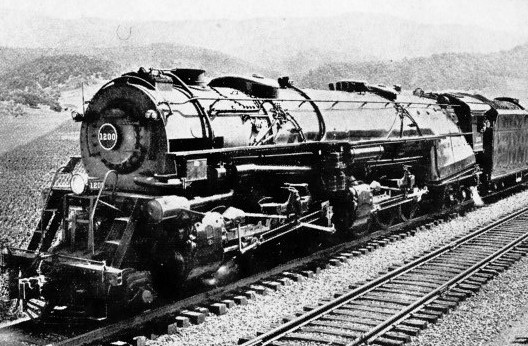
MALLET-
The record is held by the colossal “Big Boy” class of the Union Pacific Railroad, used to haul heavy freight trains over the Wasatch Mountains, between Ogden, in Utah, and Green River, Wyoming.
They have the 4-
The rear driving wheels and bogie are fixed, integrally with the main frames of the engine, while the front bogie and driving wheels are pivoted under the smoke-
The tenders for these monsters are built with fourteen wheels, and carry twenty-
Many of these massive engines have been built for oil-
Such an engine does not run backwards. Its tender, carrying oil fuel, is at the rear behind the chimney, and the oil is pumped right forward to the fire-
The tasks such mammoth locomotives are set to perform are in proportion to their size. Apart from the passenger trains, which on the chief main lines may often be more than a thousand tons in weight, freight trains are made up exclusively of high-
They travel at high speeds, too, as much as sixty miles an hour, an astonishing sight if one is not accustomed to it. On suitable routes in the States, however, a freight train of a hundred wagons whirling up the dust at this speed is no uncommon spectacle. All wagons are fitted with the same continuous brake as passenger vehicles, one of the chief reasons why such speeds are possible with safety.
A more fascinating sight is the fully streamlined train, in which America excels. All the cars have vivid external colouring, schemed from head to tail of the train in a way that varies with each company, and their, brilliance as they streak through the countryside is striking. In addition, they are furnished luxuriously with all kinds of novel interior arrangements, so that a journey becomes a pleasure in itself.
Streamlining in America
American streamlining started in 1934, and is one of the most amazingly rapid developments in railway history. The railways were suffering severely at that time from competition from both road and air transport, which, coupled with the world depression, roughly halved their passenger traffic. It was obviously necessary to do something to recover at least a part of the lost ground, and when the Germans showed the possibilities of high-
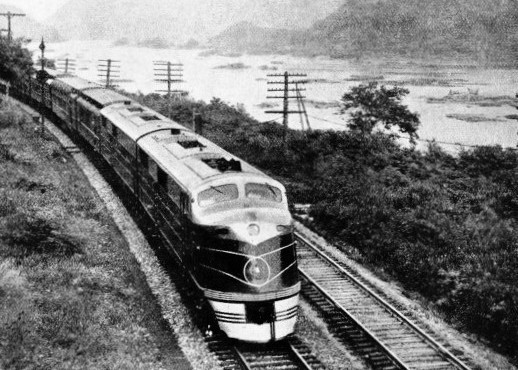
THE “CAPITOL LIMITED”, drawn by a Diesel-
The attraction does not lie only in speed, although on suitable stretches of line speeds of a hundred miles an hour are quite common, even with quite lengthy trains. The chief attraction is the pleasure of travelling in such trains, with their surprising variety of cars, including buffet cars as well as dining cars, and the solarium lounges or observation cars at the rear.
The extraordinary success of these streamlined flyers can be shown in a very simple illustration. One of the first to come into service was a train called the “Four Hundred”, which ran between Chicago and the twin cities of St. Paul and Minneapolis, a distance of just over four hundred miles. Previously, the journey had taken nine and a half hours, and most passengers had made it by sleeping-
Next, over a different line, but still between the same cities, came the Burlington “Zephyr”, a three-
Before very long, the “Four Hundred” and the “Hiawatha” had been doubled in service, with morning and afternoon streamliners, and the accommodation of the trains had been greatly increased, with the “Four Hundred” being replaced by a brand-
Most impressive of the American flyers are the luxury services operating between Chicago and the great cities of Los Angeles, San Francisco and Portland. Various companies run them over different routes, and their names are world famous. The “Super Chief” and “El Capitan” riun twice weekly in each direction over a route of roughly twenty-
All these services have a uniform schedule of just under forty hours. They start in the evening, and the passenger, spending two nights and the intervening day on board, arrives at his destination first thing in the morning. Roughly half the journey is through the Rocky Mountains, with mile after mile of heavy grades and severe curves, and very high speeds are necessary when the trains reach the open plains to keep up the average of just under sixty miles an hour for the whole journey. Runs booked at seventy and eighty miles an hour on flatter routes are common, even with trains of thirteen cars.
Among the fastest of the American flyers are the two night streamliners between Chicago and Denver, capital of Colorado, in the foothills of the Rockies. These are the “Denver Zephyr” and “City of Denver”, and they cover, roughly, a thousand and forty miles in sixteen hours, which entails an
overall average speed of sixty-
The advantage of Diesel power lies in the fact that on the longest journeys the locomotives can be worked right through without change. Crews are changed at divisional points, but the locomotive carries on. The bigger trains are headed by power plants of formidable dimensions, consisting of three seventy-
This is another advantage of Diesel-
As a final example of the possibilities of Diesel power, the “Denver Zephyr”, consisting of six cars and a locomotive of four thousand horse-
Traffic Control
Not all the long American routes are double-
The most modern and extensive development is that known as centralized traffic control, and a controlled section may be anything in length from a few miles up to more than a hundred miles. Somewhere along its length is situated the control cabin, which consists of an office containing an illuminated diagram of the whole length of track under control, and from this is operated the complete signalling installation of the section. All is done by means of electrical circuits, and in some cases even the switches giving access to the passing loops are operated from the same box.
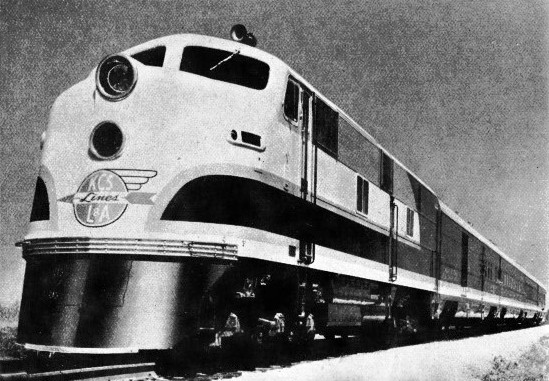
THE “SOUTHERN BELLE” runs between Kansas City and New Orleans, and links the geographical centre of the United States with the Gulf of Mexico in a run of 870 miles.
Track circuits show on the diagrams where trains are standing or in motion, and in this way the crossing of trains at the loops is arranged with the least possible loss of time. On some routes, this has reduced the times of journeys by almost a half, which makes it possible to pass nearly twice as much traffic over the line as before.
Other main lines, however, are so busy that a single track is not sufficient to carry the traffic, and here the lines are doubled, or even quadrupled. On the New York Central System, between New York and Chicago, there are no fewer than four hundred and seventy miles of continuous four-
Great precautions have been taken to promote the safety of the modern flyers. The favourite signalling method is automatic block signalling, usually with electric colour-
At the same time, however, on many of the country and branch lines, no signalling at all is in use. This sounds extraordinary, but America is well known as a land of extremes. On such lines, the movement of the trains is controlled entirely by the timetable, which gives the driver the authority to proceed. That is, he starts when it is time to do so, and any variation in the schedule from what the time-
The despatchers are in contact with one another by telegraph, and the importance of their written instructions, as, for example ordering one train to pass another at a different loop on a single line, needs no emphasis.
One serious handicap on American lines is the level crossing. The States are full of them. All lines originally were laid so that they crossed, not only highways but other railroads, at grade, or on the same level, and it is now costing tens of thousands of dollars in and around cities to build bridges or viaducts. The schemes are known as grade separation schemes, and streets and roads, as well as other lines, are being carried under or over the main lines for the first time. Obviously, with train speeds increasing as they are, the unprotected level crossing is a source either of great danger or tiresome delay.
It is because the great majority, of the thousands of level crossings through the States are unprotected, that is, have no gates or signalmen, that American locomotives are required by law to be provided with a cowcatcher and a searchlight.
The cowcatcher, so-
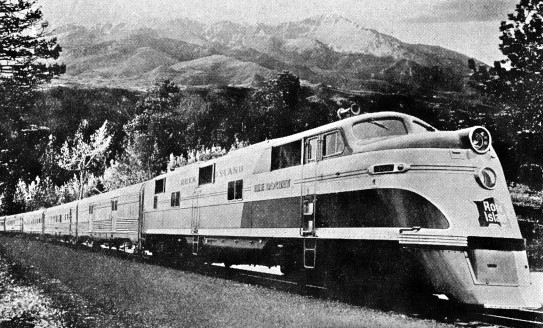
THE “ROCKY MOUNTAIN ROCKET”, new American streamliner with Diesel-
The searchlight acts as a warning to all road users at night, and can be seen for miles as the express roars along the track. To make assurance doubly sure, many of the Diesel streamliners carry two headlights, one a fixed beam which throws a light along the track ahead, and the other a rotating light, known as the Mars headlight, which throws a tremendous oscillating beam high into the sky, so that the express can be seen at night by the glow above it long before it is anywhere in view from ground level. Apart from this, the only visual warning at the crossings are prominent signs inviting the unwary to “Stop, Look, Listen”.
’
It is also compulsory to fit every locomotive with a bell and a hooter. The bell is for tolling when slow movement is taking place at stations, along streets, in yards and elsewhere, and the hooter must be sounded when travelling at speed on approaching a level crossing. Two short blasts and one long one, make up the recognized signal.
Main-
In pioneering days, it was not uncommon when the railway reached a town, to carry the track along the main street to the station, or depot, as though it were a tramway, and some of these street routes still persist, even in large cities. Until 1936, for example, such famous trains as the “Twentieth Century Limited” and the “Empire State Express” passed for a mile and a quarter up Washington Street in Syracuse, a main shopping centre in a city of two hundred thousand inhabitants in New York State. This has now been altered by building a new high-
The larger a city grows, the more difficult and costly it is to build a new track. The railway suffers great loss of time in such locations, as speed must be reduced to fifteen miles an hour for the safety of road users. Level crossings of railway over railway are equally liable to cause delay.
There are also elaborate safety precautions, apart from signalling, on the trains themselves. Every axle-
On long descending gradients through the mountains, water sprays are applied automatically to each wheel to prevent its overheating as the result of long brake application. An electric control governs the pressure of the brakes in relation to speed, and so helps to prevent skidding. Also, for the same purpose, there is an automatic sanding device which comes into operation ahead of each wheel in the event of an emergency application of the brakes.
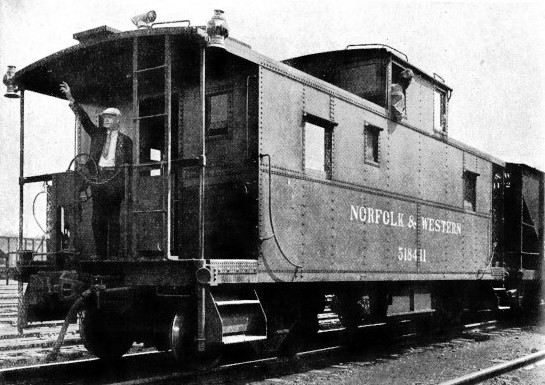
THE CABOOSE has no actual counterpart in Britain, though it approximates to the guard’s brake. It houses the travelling office headquarters and sleeping accommodation of the freight train crew and, for this reason, is much larger than its British relation. The raised “birdcage” on the roof is provided in order to give the train-
On the Diesel-
As regards electrification, all the noted expresses running from New York to Chicago and New Orleans on the Pennsylvania route are worked for a hundred and ninety miles by electrical power, that is, between New York and Harrisburg. This is part of the great Pennsylvania electrification scheme, which already covers over seven hundred and forty route-
The most important section electrified is that which connects New York with Washington, the administrative capital, by way of Philadelphia and Baltimore. For its length of two hundred and twenty-
Over this route, also, pass the famous streamliners that link New York with the beautiful Florida coast resorts, such as the “Silver Meteor” and the “Tamiami Champion”. Other famous trains using the line are the “Southerner” for New Orleans, and the “Congressional” and “Senator” for Washington. These latter run at even hourly intervals, and usually take just under four hours for the journey.
Such journeys are undertaken almost casually by the American. In a country where thousands of miles separate the principal cities, mileage has less meaning. All journeys are a question of proportion, and it is the longest journey possible in a country that sets the standard by which all the others are judged.
Comparative Distances
As an example, the longest journey for practical purposes in Great Britain is roughly one of four hundred miles, and a trip of a hundred miles, therefore, becomes a full quarter of the whole, and is subconsciously regarded as such. Applying the same attitude in a country where the longest trip is, say, two thousand miles, it would be necessary to travel five hundred to produce the same effect on the mind.
It is not possible, however, to make so long a through journey in the United States as in Canada. In Canada one can stay in the same train right across the continent, from Montreal to Vancouver. In the States, the great middle-
Nevertheless, the distances covered e the same train are considerable, and much greater use is made of sleeping accommodation than in Great Britain. The sleeping cars are built by the well-
At one time the Pullman cars were not only built by the Pullman Company, but were owned and run by them as well. The company paid a rental to the railways for permission to run the cars in their trains, and made its profit by the supplementary fares charged for the use of the accommodation. Over seven thousand such cars were maintained in a far-
That was all altered in 1914, however, when a law known as the Sherman Anti-
The first American sleeping accommodation was in cars which could be changed at will from day cars to sleepers, and quite a number of them are the same today. As night draws near, on a long journey, the porter in charge of the car prepares it for night use. Seats are drawn out to form the lower berths, and the sides of the car are let down to form the upper berths. On these the bedding is placed, and curtains are then drawn along both sides of the centre aisle to give some measure of privacy. The beds are wide and comfortable, and the only disadvantage in such an arrangement is the acrobatic performance necessary to dress and undress inside the berth, behind the shelter of the curtains. Large toilet rooms are available at each end of the cars.
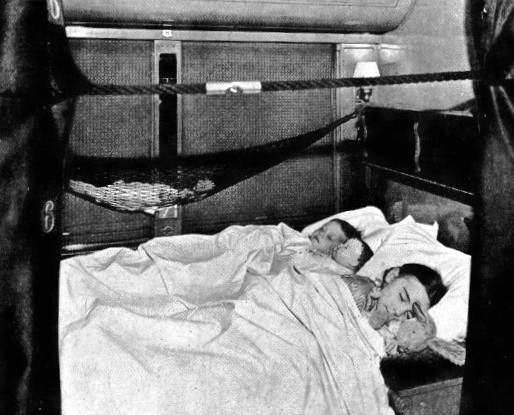
VERY COMFORTABLE, a Pullman car section turned into sleeping quarters for the night. The curtains in front can be drawn right across the berth, giving a measure of privacy. Compartments such as this form armchair seats during the day — two double seats facing each other — and are arranged on each side of a central gangway.
At the rear of this older type of sleeping car is a compartment known as the drawing room, a completely enclosed room with two or three beds, which can be engaged at a slightly higher cost than one of the sections. At one time, this was the most luxurious form of sleeping accommodation available, but a great many more varieties of sleeping berths are in use today.
There are, for example, the roomettes, which are small rooms dovetailed into one another along both sides of a central corridor. In the daytime the roomette is occupied as a sort of lounge, and there is no sign of a bed. The passenger is free to remain as long as he pleases on one of the comfortable lounge seats.
At night, however, when he wishes to sleep, the bed, folded up against the wall, slides down at a touch all ready for use. More capacious than these are the single bedrooms and double bedrooms which are to be had on most of the night expresses, and on some even a complete suite can be obtained, including a private shower-
For day use, there are equally luxurious parlour or lounge cars of many different kinds, including the popular observation cars which bring up the rear of most American express trains. These are a development from the early open-
The dining cars are also magnificently decorated, many of them conveying all the illusion of a restaurant, especially at night. Part of the car may be windowless, and along the enamelled and decorated walls are seats and concealed lighting. At the ends there may be the more usual transverse tables.
Novelty appeal is the keynote of all these interior coach schemes. Nor is the passenger limited to a set meal, but has a choice of as wide a variety of courses as in a regular restaurant. Further, few long distance trains have a dining car only; on many there are buffets and light refreshment cars, and on some trains more than one.
American third-
The third-
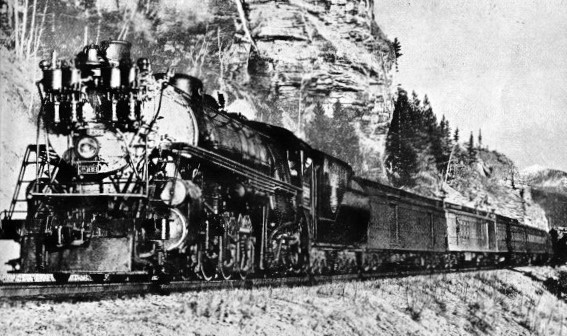
THE “EMPIRE BUILDER”. This express, which is worked by the Burlington and Great Northern Railway between Chicago and Seattle, is here photographed being hauled by a Great Northern 4-
Taking tickets for these long journeys is generally a complicated business, because it includes the reservation of sleeping accommodation or a numbered seat in a chair car. The time-
Nearly all long-
The lavishness of the service frequently results in an additional service charge being made, which is not surprising. To take one extreme example, the staff riding with the !Twentieth Century Limited”, on its long run from New York to Chicago, is never less than forty-
The complete train of sixteen cars is made up as follows: first comes the baggage and mail car, and this is followed by a buffet-
One of the most distinctive features of the working of such long-
All express trains are now completely air-
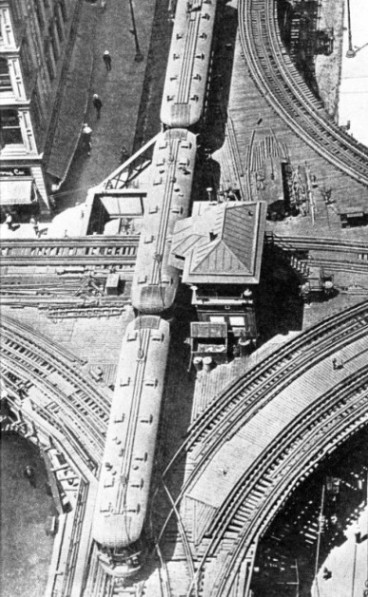 What a contrast against the old days when the pioneer track unfolded itself across the western prairies! Then the mere fact that one could be reasonably sure of reaching one’s destination in safety was a tremendous step forward. The modern flyers are like moving hotels, providing all the conveniences of a first-
What a contrast against the old days when the pioneer track unfolded itself across the western prairies! Then the mere fact that one could be reasonably sure of reaching one’s destination in safety was a tremendous step forward. The modern flyers are like moving hotels, providing all the conveniences of a first-
Road and air undoubtedly have a part to play in future transport over long distances, each in the manner best suited to its own sphere, but in a vast country like America, not only the heavy freight traffic, but also the great bulk of the passenger traffic, will long be carried by that most characteristic of American institutions — the railroad.
ELEVATED RAILWAY CROSSING, photographed from a Chicago skyscraper. The “elevated” still runs in Chicago, with all its accompanying noise and nuisance, and this crossing over Lake and Wells Streets is reputed to be the busiest on any elevated railway in the world. Two hundred and twenty-
You can read more on “Giant American Locomotives”, “North American Railroads”, “Speed Trains of North America” and “Union Pacific Streamlined Express” on this website.